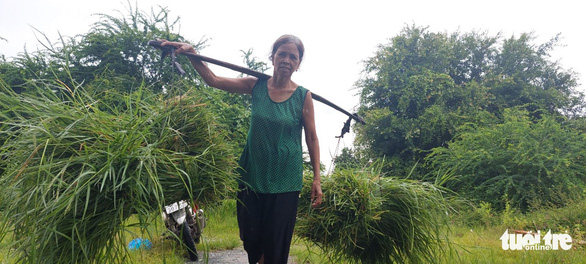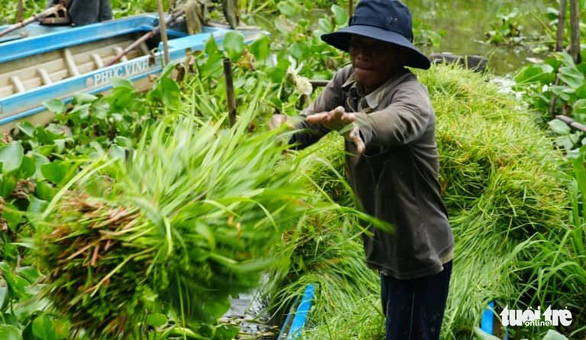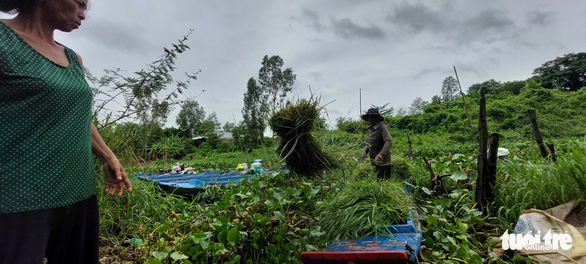The wild land in the border district of Tri Ton in An Giang Province, located in the Mekong Delta of Vietnam, is gradually shrinking, sparking concerns over a shortage of grass, so residents there are rushing to buy the plant daily.
Every day, in the midday sun, Neang Kien, 62, who lives in Phuoc Loc Hamlet, O Lam Commune, Tri Ton District, and dozens of men, women, and children patiently wait at the river shore next to the commune’s wet market to buy grass.
One topical issue at the market is the misery caused by water hyacinths.
“If only the grass were as plentiful as the water hyacinths, life here would be much easier,” a woman stated while waiting to buy grass with impatience.
There was not enough grass to feed her four cows the day before. If there is no grass now, her only choice is to sell them off.
Various types of goods transported by river are jammed due to water hyacinths. Yet the one that must be circulated is grass, which is a great concern for most residents in O Lam.
On a daily basis, many O Lam residents are present at this river shore when the sun rises. Over the past decades, the river shore has been the only place for daily grass trading, regardless of floods, storms or droughts.
Grass for sale is gathered there every day. Deals on grass are closed rapidly.
When each boat full of grass reaches the river wharf, the orders are placed with hand gestures or in the Southern Khmer dialect ‘Khnhum pram’,’ ‘Khnhum pram pi’ or ‘Khnhum pram pay.’
After the deals are made, the bundles of grass are thrown toward the riverbank for buyers.
|
|
| As soon as the two parties agree, the bundles of grass are thrown to the buyers. Photo: Tien Trinh / Tuoi Tre |
Grass is currently in high demand in O Lam, with their prices varying from VND10,000 (US$0.42) per two bundles to VND10,000 per three bundles.
Dozens of boats packed with grass arrive at the river shore near the O Lam market in turn. In the blink of an eye, the grass is sold out.
“The grass here is selling like hot cakes,” Chau Ruol said, adding that the number of cows is inherently high, and now it is even higher as local authorities have launched a cow support project for the Khmer people.
“The poor are also able to own cows. Occasionally, people run out of rice, but the cows can’t run out of grass,” Ruol said.
It is past 1:00 pm but many people are still seeking shelter under a Manila tamarind tree to wait for the last boat operated by the Chau Mon couple.
When the sun is at its strongest, the heavy sound of the engine from the river intersection is a hopeful sign for everyone.
Many rush toward the cement bridge down the river to buy grass for their starving cows.
“The deluge of water hyacinths in the river slows down transportation. Moreover, grass has run out recently, so we must reach an area bordering Kien Giang [also in the Mekong Delta region] to cut grass,” the couple explained why buyers had to wait so long.
|
|
| A seller throws a bundle of grass to a woman after a deal is done in An Giang Province, Vietnam. Photo: Tuoi Tre |
Looking for grass daily
“The grass for my cow is as much as I earn from my banana cakes,” Neang Kien said, implying the amount earned from selling banana cakes is just enough to buy grass for her cow.
“It is OK if I am hungry but I will be sick if the cow is underweight.”
Raising a cow is like loving a dog or a cat, Neang Kien said, adding most of her daily income is spent on grass.
Ten years ago, grass became a big concern for O Lam residents.
Neang Hon, 46, who resides in O Ta Tung in O Lam Commune, says that while rice is abundant, grass is running out, but the demand for grass to feed the cows is increasingly high. People use land to grow rice instead of planting grass as food for cows.
Neang Hon recalled that in the past, the land was immense and the number of residents growing rice was low, so cow breeders just needed to pasture the cows. Back then, it cost her family almost nothing to buy grass for the cows. The picture of cows on the meadow under the Palmyra palm trees became so familiar to the residents of the Seven Mountains region, or Bay Nui, in An Giang.
Yet the situation changed when the residents started to grow rice crops, leaving no grassland for the cows.
“Even if grass is available, no one dares to use it to feed the cows, as farmers use fertilizer and pesticides to grow rice,” Neang Hon elaborated.
“For this reason, the grass is not healthy for cows.”
When the floods hit the land and the droughts burned the grass, the residents of Bay Nui had to go all the way to Giang Thanh, Tam Ngan, Hon Dat, or even to the fields that border Cambodia, to find grass for their cows.
|
|
| The grass on board the Chau Mon couple’s boats is quickly sold out, while many people go empty-handed. Photo: Tien Trinh / Tuoi Tre |
At first, they just cut enough grass to feed their cows for several days, then the journey continued for longer.
However, they realized that it was a waste of effort when making a great attempt to reach the further lands for days and months in return for just enough grass for the cattle.
As for the busy residents, taking the long journey was impossible so they decided to support each other. The grass brought home can be shared with neighbors, said 42-year-old Neang Son.
Neang Son also said that the herds in O Lam are able to overcome the floods or the droughts partly thanks to people who use their own boats or vehicles to look for grass. They sell the plant to cattle raisers in the hamlets and receive a little money.
However, grass-seeking trips are going further and further, making them more expensive and more time-consuming, which raises the cost of the grass as well. Each grass bundle is priced at VND2,000 and a cow needs 5-10 bundles per day.
Gradually, grass has become essential to the cow raisers in O Lam Commune so the families of Ut Dal, Ron Hen, Ta Hen, Mon Thia, and Ca Ron have become professional grass traders.
Chau Rene, 52, said that to meet the demand for grass, he must get up early, sail his boat before the roosters crow, and come home when the sun is high. Their area ranges from the southwest border to the Long Xuyen Tetragon. Wild pastures are fewer and fewer, so grass seekers must go further and further.
“I am not fearful of hardship, but the danger is everywhere. The biggest concern is snakes when I must thread my way through the wild land to cut grass,” said Rene.
Neang Kien recounted that many families have sold all of their cows to head to the southeast region to find a job due to the dearth of grass.
Meanwhile, Chau Son, another resident, said, “Here, each family must have at least one cow which is not only their savings account but also their guarantee for life.”
The cow raisers here are fond of wild grass so there are still the hard-working sellers going all the way to find grass. Thanks to this, O Lam is still busy with grass sellers and buyers.
Like us on Facebook or follow us on Twitter to get the latest news about Vietnam!





















































